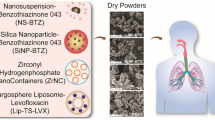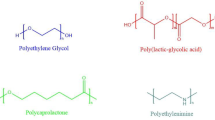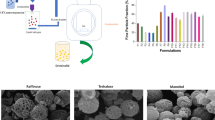Abstract
Purpose
Dry powder vaccine delivery via the pulmonary route has gained significant attention as an alternate route to parenteral delivery. In this study, we investigated bovine serum albumin (BSA) adsorbed poly(glycerol adipate-co-ω-pentadecalactone), PGA-co-PDL polymeric nanoparticles (NPs) within L-leucine (L-leu) microcarriers for dry powder inhalation.
Methods
NPs were prepared by oil-in-water single emulsion-solvent evaporation and particle size optimised using Taguchi’s design of experiment. BSA was adsorbed onto NPs at different ratios at room temperature. The NPs were spray-dried in aqueous suspension of L-leu (1:1.5) using a Büchi-290 mini-spray dryer. The resultant nanocomposite microparticles (NCMPs) were characterised for toxicity (MTT assay), aerosolization (Next Generation Impactor), in vitro release study and BSA was characterized using SDS-PAGE and CD respectively.
Results
NPs of size 128.50 ± 6.57 nm, PDI 0.07 ± 0.03 suitable for targeting lung dendritic cells were produced. BSA adsorption for 1 h resulted in 10.23 ± 1.87 μg of protein per mg of NPs. Spray-drying with L-leu resulted in NCMPs with 42.35 ± 3.17% yield. In vitro release study at 37°C showed an initial burst release of 30.15 ± 2.33% with 95.15 ± 1.08% over 48 h. Aerosolization studies indicated fine particle fraction (FPF%) dae < 4.46 μm as 76.95 ± 5.61% and mass median aerodynamic diameter (MMAD) of 1.21 ± 0.67 μm. The cell viability was 87.01 ± 14.11% (A549 cell line) and 106.04 ± 21.14% (16HBE14o- cell line) with L-leu based NCMPs at 1.25 mg/ml concentration after 24 h treatment. The SDS-PAGE and CD confirmed the primary and secondary structure of the released BSA.
Conclusions
The results suggest that PGA-co-PDL/L-leu NCMPs may be a promising carrier for pulmonary vaccine delivery due to excellent BSA adsorption and aerosolization behaviour.








Similar content being viewed by others
Abbreviations
- APCs:
-
Antigen presenting cells
- BSA:
-
Bovine serum albumin
- DCs:
-
Dendritic cells
- DoE:
-
Design of experiment
- LN:
-
Lymph node
- NPs:
-
Nanoparticles
- NCMPs:
-
Nanocomposite microparticles
- PGA-co-PDL:
-
Poly(glycerol adipate-co-ω-pentadecalactone)
- PLA:
-
Polylactide or poly-L-lactic acid
- PLGA:
-
Poly lactic-co-glycolic-acid
- PVA:
-
Polyvinyl alcohol
- SD:
-
Spray-drying
References
Leleux J, Roy K. Micro and nanoparticle-based delivery systems for vaccine immunotherapy: an immunological and materials perspective. Adv Healthc Mater. 2013;2:72–94.
Akagi T, Baba M, Akashi M. Biodegradable nanoparticles as vaccine adjuvants and delivery systems: regulation of immune responses by nanoparticle-based vaccine. Adv Polym Sci. 2012;247:31–64.
Kunda N, Somavarapu S, Gordon S, Hutcheon G, Saleem I. Nanocarriers targeting dendritic cells for pulmonary vaccine delivery. Pharm Res. 2013;30:325–41.
Amorij JP, Saluja V, Petersen AH, Hinrichs WLJ, Huckriede A, Frijlink HW. Pulmonary delivery of an inulin-stabilized influenza subunit vaccine prepared by spray-freeze drying induces systemic, mucosal humoral as well as cell-mediated immune responses in BALB/c mice. Vaccine. 2007;25:8707–17.
Thomas C, Rawat A, Hope-Weeks L, Ahsan F. Aerosolized PLA and PLGA nanoparticles enhance humoral, mucosal and cytokine responses to hepatitis B vaccine. Mol Pharm. 2010;8:405–15.
Panyam J, Labhasetwar V. Biodegradable nanoparticles for drug and gene delivery to cells and tissue. Adv Drug Deliv Rev. 2003;55:329–47.
Kallinteri P, Higgins S, Hutcheon GA, St. Pourçain CB, Garnett MC. Novel functionalized biodegradable polymers for nanoparticle drug delivery systems. Biomacromolecules. 2005;6:1885–94.
Tawfeek H, Khidr S, Samy E, Ahmed S, Murphy M, Mohammed A, et al. Poly(glycerol adipate-co-ω-pentadecalactone) spray-dried microparticles as sustained release carriers for pulmonary delivery. Pharm Res. 2011;28:2086–97.
Tawfeek HM, Evans AR, Iftikhar A, Mohammed AR, Shabir A, Somavarapu S, et al. Dry powder inhalation of macromolecules using novel PEG-co-polyester microparticle carriers. Int J Pharm. 2013;441:611–9.
Thompson CJ, Hansford D, Higgins S, Rostron C, Hutcheon GA, Munday DL. Evaluation of ibuprofen-loaded microspheres prepared from novel copolyesters. Int J Pharm. 2007;329:53–61.
Duncan G, Jess TJ, Mohamed F, Price NC, Kelly SM, Van der Walle CF. The influence of protein solubilisation, conformation and size on the burst release from poly(lactide-co-glycolide) microspheres. J Control Release. 2005;110:34–48.
Peek LJ, Middaugh CR, Berkland C. Nanotechnology in vaccine delivery. Adv Drug Deliv Rev. 2008;60:915–28.
Saleem IY, Vordermeier M, Barralet JE, Coombes AGA. Improving peptide-based assays to differentiate between vaccination and mycobacterium bovis infection in cattle using nanoparticle carriers for adsorbed antigens. J Control Release. 2005;102:551–61.
Sou T, Meeusen EN, De Veer M, Morton DA V, Kaminskas LM, McIntosh MP. New developments in dry powder pulmonary vaccine delivery. Trends Biotechnol. 2011;29:191–8.
Manolova V, Flace A, Bauer M, Schwarz K, Saudan P, Bachmann MF. Nanoparticles target distinct dendritic cell populations according to their size. Eur J Immunol. 2008;38:1404–13.
Kim H, Uto T, Akagi T, Baba M, Akashi M. Amphiphilic poly(amino acid) nanoparticles induce size-dependent dendritic cell maturation. Adv Funct Mater. 2010;20:3925–31.
Foged C, Brodin B, Frokjaer S, Sundblad A. Particle size and surface charge affect particle uptake by human dendritic cells in an in vitro model. Int J Pharm. 2005;298:315–22.
Bilati U, Allémann E, Doelker E. Poly(D,L-lactide-co-glycolide) protein-loaded nanoparticles prepared by the double emulsion method—processing and formulation issues for enhanced entrapment efficiency. J Microencapsul. 2005;22:205–14.
Li X, Deng X, Yuan M, Xiong C, Huang Z, Zhang Y, et al. Investigation on process parameters involved in preparation of poly-dl-lactide-poly(ethylene glycol) microspheres containing Leptospira Interrogans antigens. Int J Pharm. 1999;178:245–55.
Sanad R, Abdel Malak N, El-Bayoomy T, Badawi AA. Preparation and characterization of oxybenzone-loaded solid lipid nanoparticles (SLNs) with enhanced safety and sunscreening efficacy: SPF and UVA-PF. Drug Discov Ther. 2010;4:472–83.
Stevanovic M, Uskokovic D. Poly(lactide-co-glycolide)-based micro and nanoparticles for the controlled drug delivery of vitamins. Curr Nanosci. 2009;5:1–14.
Li H-Y, Seville PC, Williamson IJ, Birchall JC. The use of amino acids to enhance the aerosolization of spray-dried powders for pulmonary gene therapy. J Gene Med. 2005;7:343–53.
Seville PC, Learoyd TP, Li H-Y, Williamson IJ, Birchall JC. Amino acid-modified spray-dried powders with enhanced aerosolization properties for pulmonary drug delivery. Powder Technol. 2007;178:40–50.
Bosquillon C, Lombry C, Préat V, Vanbever R. Influence of formulation excipients and physical characteristics of inhalation dry powders on their aerosolization performance. J Control Release. 2001;70:329–39.
Al-fagih IM, Alanazi FK, Hutcheon GA, Saleem I. Recent advances using supercritical fluid techniques for pulmonary administration of macromolecules via dry powder formulations. Drug Deliv Lett. 2011;1:128–34.
Bailey MM, Berkland CJ. Nanoparticle formulations in pulmonary drug delivery. Med Res Rev. 2009;29:196–212.
Soppimath KS, Aminabhavi TM, Kulkarni AR, Rudzinski WE. Biodegradable polymeric nanoparticles as drug delivery devices. J Control Release. 2001;70:1–20.
Thompson CJ, Hansford D, Higgins S, Hutcheon GA, Rostron C, Munday DL. Enzymatic synthesis and evaluation of new novel ω-pentadecalactone polymers for the production of biodegradable microspheres. J Microencapsul. 2006;23:213–26.
Pinto Reis C, Neufeld RJ, Ribeiro AJ, Veiga F. Nanoencapsulation I. Methods for preparation of drug-loaded polymeric nanoparticles. Nanomedicine: NBM. 2006;2:8–21.
Do KK, Kim SH, Kim HT. Applying the Taguchi method to the optimization for the synthesis of TiO2 nanoparticles by hydrolysis of TEOT in micelles. Colloids Surf A Physicochem Eng Asp. 2005;254:99–105.
Greenfield NJ. Using circular dichroism spectra to estimate protein secondary structure. Nat Protoc. 2007;1:2876–90.
Henzler Wildman KA, Lee D-K, Ramamoorthy A. Mechanism of lipid bilayer disruption by the human antimicrobial peptide, LL-37†. Biochemistry. 2003;42:6545–58.
Whitmore L, Woollett B, Miles AJ, Janes RW, Wallace BA. The protein circular dichroism data bank, a web-based site for access to circular dichroism spectroscopic data. Structure (Lond Engl 1993). 2010;18:1267–9.
Whitmore L, Wallace BA. Protein secondary structure analyses from circular dichroism spectroscopy: methods and reference databases. Biopolymers. 2008;89:392–400.
Whitmore L, Wallace BA. DICHROWEB, an online server for protein secondary structure analyses from circular dichroism spectroscopic data. Nucleic Acids Res. 2004;32:W668–73.
Abbate V, Kong X, Bansal SS. Photocrosslinked bovine serum albumin hydrogels with partial retention of esterase activity. Enzym Microb Technol. 2012;50:130–6.
Zhang J, Ma X, Guo Y, Yang L, Shen Q, Wang H, et al. Size-controllable preparation of bovine serum albumin-conjugated PbS nanoparticles. Mater Chem Phys. 2010;119:112–7.
Douglas SJ, Illum L, Davis SS. Particle size and size distribution of poly(butyl 2-cyanoacrylate) nanoparticles. II. Influence of stabilizers. J Colloid Interface Sci. 1985;103:154–63.
Mitra A, Lin S. Effect of surfactant on fabrication and characterization of paclitaxel-loaded polybutylcyanoacrylate nanoparticulate delivery systems. J Pharm Pharmacol. 2003;55:895–902.
Jalil R, Nixon JR. Microencapsulation using poly (L-lactic acid) III: effect of polymer molecular weight on the microcapsule properties. J Microencapsul. 1990;7:41–52.
Mittal G, Sahana DK, Bhardwaj V, Ravi Kumar MN V. Estradiol loaded PLGA nanoparticles for oral administration: effect of polymer molecular weight and copolymer composition on release behavior in vitro and in vivo. J Control Release. 2007;119:77–85.
Joshi V, Geary S, Salem A. Biodegradable particles as vaccine delivery systems: size matters. AAPS J. 2013;15:85–94.
Sloat BR, Sandoval MA, Hau AM, He Y, Cui Z. Strong antibody responses induced by protein antigens conjugated onto the surface of lecithin-based nanoparticles. J Control Release. 2010;141:93–100.
Yoon J-Y, Kim J-H, Kim W-S. The relationship of interaction forces in the protein adsorption onto polymeric microspheres. Colloids Surf A Physicochem Eng Asp. 1999;153:413–9.
Regev O, Khalfin R, Zussman E, Cohen Y. About the albumin structure in solution and related electro-spinnability issues. Int J Biol Macromol. 2010;47:261–5.
Li H-Y, Neill H, Innocent R, Seville P, Williamson I, Birchall JC. Enhanced dispersibility and deposition of spray-dried powders for pulmonary gene therapy. J Drug Target. 2003;11:425–32.
Sou T, Kaminskas LM, Nguyen T-H, Carlberg R, McIntosh MP, Morton DA V. The effect of amino acid excipients on morphology and solid-state properties of multi-component spray-dried formulations for pulmonary delivery of biomacromolecules. Eur J Pharm Biopharm. 2013;83:234–43.
Yang L, Guo Y, Ma X, Hu Z, Zhu S, Zhang X, et al. Cooperativity between pepsin and crystallization of calcium carbonate in distilled water. J Inorg Biochem. 2003;93:197–203.
Tildon JT, Ogilvie JW. The esterase activity of bovine mercaptalbumin. The reaction of the protein with p-nitrophenyl acetate. J Biol Chem. 1972;247:1265–71.
Córdova J, Ryan JD, Boonyaratanakornkit BB, Clark DS. Esterase activity of bovine serum albumin up to 160°C: a new benchmark for biocatalysis. Enzym Microb Technol. 2008;42:278–83.
Feng AL, Boraey MA, Gwin MA, Finlay PR, Kuehl PJ, Vehring R. Mechanistic models facilitate efficient development of leucine containing microparticles for pulmonary drug delivery. Int J Pharm. 2011;409:156–63.
Najafabadi AR, Gilani K, Barghi M, Rafiee-Tehrani M. The effect of vehicle on physical properties and aerosolization behaviour of disodium cromoglycate microparticles spray dried alone or with l-leucine. Int J Pharm. 2004;285:97–108.
Todoroff J, Ucakar B, Inglese M, Vandermarliere S, Fillee C, Renauld J-C, et al. Targeting the deep lungs, poloxamer 407 and a CpG oligonucleotide optimize immune responses to mycobacterium tuberculosis antigen 85A following pulmonary delivery. Eur J Pharm Biopharm. 2013;84(1):40–8.
Menzel M, Muellinger B, Weber N, Haeussinger K, Ziegler-Heitbrock L. Inhalative vaccination with pneumococcal polysaccharide in healthy volunteers. Vaccine. 2005;23:5113–9.
ACKNOWLEDGMENTS AND DISCLOSURES
We would like to thank Dr Mark Murphy (Liverpool John Moores University, Liverpool, UK) for his help with confocal microscopy studies
Author information
Authors and Affiliations
Corresponding author
Rights and permissions
About this article
Cite this article
Kunda, N.K., Alfagih, I.M., Dennison, S.R. et al. Bovine Serum Albumin Adsorbed PGA-co-PDL Nanocarriers for Vaccine Delivery via Dry Powder Inhalation. Pharm Res 32, 1341–1353 (2015). https://doi.org/10.1007/s11095-014-1538-5
Received:
Accepted:
Published:
Issue Date:
DOI: https://doi.org/10.1007/s11095-014-1538-5




